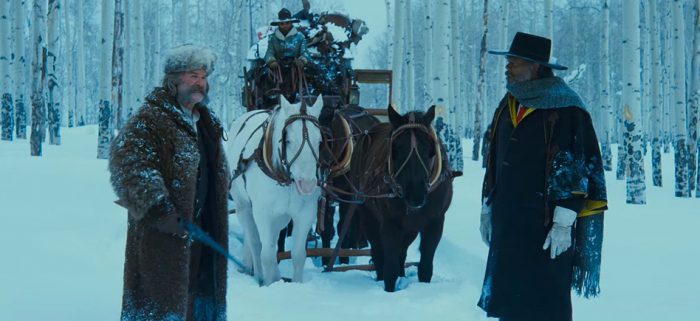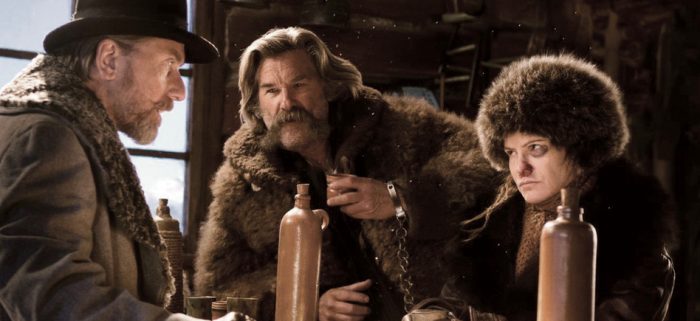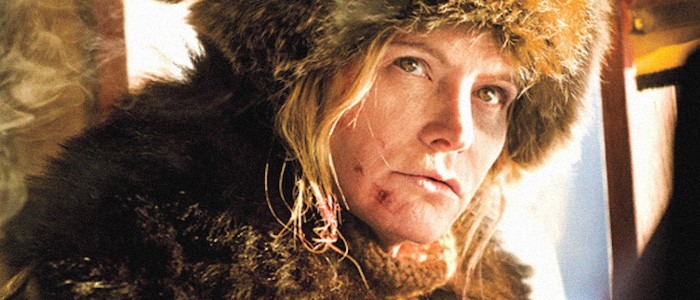Exclusive: Quentin Tarantino Tells Us How and Why He Created ‘The Hateful Eight’ Miniseries for Netflix
A month ago, word arrived that an extended version of Quentin Tarantino‘s 2015 Western The Hateful Eight would be arriving on Netflix. Many (including this writer) assumed this was going to be the Roadshow Cut – a cut that played in limited theatrical release, and was never released on home video. But that’s not what happened.
Instead, The Hateful Eight arrived on Netflix broken into a miniseries, consisting of four episodes. How, and why, did this happen? And was Tarantino involved? It turns out he was. The filmmaker curated and oversaw the new miniseries cut himself.
Tarantino spoke to /Film exclusively about how the Hateful Eight Netflix miniseries came together. The filmmaker also spoke of a new director’s cut of another one of his films, and whether or not he’s going to make that rumored Star Trek movie.
So I guess my two big questions on this are how and why; how did this come about and how much input did you have into it? And what was the genesis of it, breaking it up into these episodes?
Well, we finished the whole run of the movie. And I had no reason to at this time to put the Roadshow version out; because that was [its own thing]…it was about that 70 millimeter screening. So as far as like the whole prologue and the intermission, that didn’t seem to really make much sense, unless it was playing on TCM Roadshow week or something.
So Netflix came to us and said, “Hey, look, if you’d be interested…If there’s even more footage, if you’d be interested in putting it together and in a way that we could show it as three or four episodes, depending on how much extra footage you have, we’d be willing to do that.”
And I thought, wow, that’s really intriguing. I mean, the movie exists as a movie, but if I were to use all the footage we shot, and see if I could put it together in episode form, I was game to give that a shot, give that a try.
And so about a year after it’s released, maybe a little less, me and my editor, Fred Raskin, we got together and then we worked real hard. We edited the film down into 50 minute bits, and we very easily got four episodes out of it. We didn’t re-edit the whole thing from scratch, but we did a whole lot of re-editing, and it plays differently. Some sequences are more similar than others compared to the film, but it has a different feeling. It has a different feeling that I actually really like a lot. And there was a literary aspect to the film anyway, so it definitely has this “chapters unfolding” quality.
There’s been some debate about whether or not there’s new footage–
Yeah, it’s really frustrating that on one hand, it seems like every website in the world wants to write about it, but no one wants to actually watch it. So they could actually see for themselves if it’s different. Like, 42 different websites would rather speculate on if it’s different rather than just watch it. So it’s all this misconception. “Oh, they’re just replaying the credits…it’s just only what was in the roadshow version.” No! I don’t know [an exact] timeline as far as how much new footage is in it, but it’s something like about, like, 25 minutes if not more.
And there are sequences that play very different. You know, one of the things in it that I like a lot, and it was one of the things [that] didn’t quite work in the feature, we had moved on, but in this kind of situation it was different. Where, um…Have you seen the movie?
Yes.
Okay. So when you have the situation where the four passengers come in, and take over the place and kill everybody, and they kind of set up the place for when the stagecoach arrives.
Well, the way it’s in the [original] movie is, instead of me saying, “But then when John Ruth and Daisy arrived…”, that’s when we cut out of that sequence, and go back….What we’re able to do in this version, is John Ruth and Daisy now enter the place, and you see the entire sequence again. John Ruth and Daisy enter Minnie’s Haberdashery, except now it’s not told from John Ruth and Daisy’s perspective. It’s told from the killers’ perspective…We know what they’ve done, and we know how they set up, and we know Daisy knows who they are…So we see how Tim Roth and how Michael Madson and how Daisy are reacting to each other, while John Ruth is oblivious.
I have a question just about the movie itself. I’m wondering if you yourself think this movie came out like a year or two early. I remember this came out Christmas 2015 and I remember there was this – I loved the movie, first of all, I think it’s fantastic. But it’s a really brutal movie. It deals with misogyny and racism, and obviously those things aren’t new. They’ve always been there, but it seems like a year later, you know, we had the election and all this…all this ugly stuff that I feel like a lot of Americans thought was buried came out again in, in full force. And when that happened, it made me think of this movie a lot because I feel like the movie is dealing with that in some way.
Yeah, they’re still fighting the war…in their own racist terms.
It felt like if this had come out in 2016 instead of 2015 the reaction would have been so much different, just because that ugliness was at the forefront again.
Well, just so you’ll know, I read your piece. I was really taken with it. I really liked it. I, uh, I appreciate you calling us prescient. I have to say…I didn’t really think about it [at the time]. Like I knew I had made an ugly little movie. And if you make an ugly little movie people might not respond so great, okay, that goes with wanting to make something, uh, this rancid. But I love it…but I can understand it’s not really a dish for everybody but the truth of the matter is, I didn’t think about any of that. I just thought it was just the nature of the beast. But when I read your piece, I was like, “Hey, he might have a point.”
So going back to the Netflix element, would you want to do something like this again, for like, say, [Kill Bill] The Whole Bloody Affair? Or is this a one time thing for you?
[There’s] the idea that now you can make a movie, and the movie is the movie, and the movie has all the limitations that the movie has that a novel doesn’t have, that’s the way it is. But the idea that after that, after that is done, after that movie is said and done, not that that’s just some ghost or some weird little version, but the idea that you could have a fuller version come out, after the fact, that’s kind of exciting. That’s kind of interesting. Now, in the case of Kill Bill the Whole Bloody Affair, Kill Bill is the one movie I’ve made where everything I shot is in the movie, because we had two movies.
But for instance, take Django [Unchained], I’ve actually cut a director’s cut of Django. That’s about like three hours and 15 minutes, or three hours and 20 minutes, something like that. That’s one I wouldn’t do as a miniseries, because it would just be better [as a movie]. I thought about that idea, but that would just work better as one movie. Just a longer one as far as I was concerned. So I’ve actually done that. We’re just kind of waiting some time after Once Upon A Time in Hollywood, and we’ll release that eventually
And what’s the status of Once Upon a Time in Hollywood?
I’m on the mix-stage right now.
I feel like I have to ask this even though I don’t know if you’ll want to answer. But are you going to make a Star Trek movie? Is there any truth to that?
It’s a very big possibility. I haven’t been dealing with those guys for a while cause I’ve been making my movie. But we’ve talked about a story and a script. The script has been written and when I emerge my head like Punxsutawney Phil, post-Once Upon a Time in Hollywood, we’ll pick up talking about it again.
With the Hateful Eight Netflix cut, what would you say to interest people; to tell them this is something new instead of just what they’ve seen before?
Well if you like the movie, the movie is a movie, and I worked really hard [on it]. So even if I come out with a version that has more stuff in it, that doesn’t invalidate the first version.
The first version is what we chose to be the movie. But now if you’ve seen that, and you like that, and you want more, this version gives you more…and it gives you more in a slightly different format. The movie doesn’t necessarily need to be like one longer movie. It was a pretty long movie [to begin with]. But this gave me an opportunity to, rather than just make a super duper epic, I could actually use all of my ideas…my scripts are always told with really complex narrative ideas…
Now, in the course of editing a movie, a lot of those ideas go by the wayside, because ultimately it’s not serving your purpose for making a linear movie. But in this case, I was able to put it all back in. And if you’re just watching it like a chapter at a [time], which is basically 50 minutes at a time, then you’re able to absorb it. And in a fun way, you’re able to look at it slightly differently. Do you want to keep watching it? You can, but you don’t have to. Each episode ends it an emotional place and you’re also able to see the whole original narrative complexity of the whole piece.
The post Exclusive: Quentin Tarantino Tells Us How and Why He Created ‘The Hateful Eight’ Miniseries for Netflix appeared first on /Film.
from /Film http://bit.ly/2XVcNWL
via IFTTT



Comments
Post a Comment